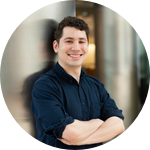About This Project
Addressing climate change requires new approaches for fixation of CO2. Inspired by nature, Rubisco, the central enzyme of photosynthesis, may offer a route for reducing CO2. However, efforts are limited by the efficiency and specificity of Rubisco, with difficulties for both rational and directed evolution engineering approaches. We will engineer Rubisco via machine-learning assisted directed evolution, allowing for rapid generation of new variants suitable for broad-scale carbon capture.
Ask the Scientists
Join The DiscussionWhat is the context of this research?
Excessive CO2 in the atmosphere exacerbates global warming and poses significant environmental challenges. Synthetic carbon removal technologies, such as direct air capture, are burdened by high energy consumption, significant infrastructure demands, and steep costs. Natural carbon fixation through photosynthesis offers a potential solution: carbon fixing enzymes such as Rubisco leverage photosynthesis—a process evolved over millions of years—to capture carbon efficiently, and can be scaled via traditional agricultural approaches to both fix carbon and increase crop yields [1]. However, Rubisco operates in a regime of sub-par efficiency, due to both evolutionary and catalytic constraints [2]. Improvements to Rubisco would provide a new, scalable approach for fixing CO2.
What is the significance of this project?
Previous efforts to engineer Rubsico for improved activity have failed, in part due to the complexity of the Rubsico fitness landscape [2]. Recent advancements in AI-driven protein engineering have succeeded in enhancing the functionality of various enzymes, more efficiently traversing protein fitness landscapes and identifying complex mutants with higher activity [3]. AI-assisted evolution of Rubisco could overcome current limitations, leading to both improved activity and increased specificity for CO2 over oxygen. These enzymes could curb greenhouse gas levels while integrating seamlessly with existing agricultural practices. The project's success could establish a precedent for leveraging AI in bioengineering, unlocking new avenues for environmentally sustainable biotechnologies.
What are the goals of the project?
Our primary objective is to genetically engineer Rubisco to improve both efficiency and specificity for CO2, over O2. With this overall goal in mind, this project will:
Demonstrate successful AI-assisted directed evolution on existing deep scanning mutagenesis protein datasets
Improve the speed and cost-efficiency of directed evolution by 10x, while only evaluating a small subset of mutants
Develop dual biochemical and cellular assay capable of rapid interrogation of Rubisco variants.
Evolve 200-300% higher Rubisco carboxylation efficiency (state of the art is ~60% [4])
Increase selectivity for CO2 at least 200x (state of the art is ~100x [5], [6]). This objective is important as selectivity commonly decreases when improving carboxylation efficiency.
Budget
This budget will be used for creating the general LLM protein directed evolution model and then showing that it can be used for evolution of different Rubisco orthologs.
 Project Timeline
Project Timeline
Expected timeline is about 12 months as follows:
Demonstrate the success of LLM-assisted directed evolution on existing datasets (months 1-6).
Evolve Rubisco variants with 200-300% higher carboxylation efficiency (state of the art is ~60%) (months 6-12).
Increase Rubisco selectivity for CO2 at least 200x (state of the art is ~100x). This objective is important as selectivity commonly decreases when improving carboxylation efficiency (months 6-12).
May 01, 2024
Demonstrate the success of LLM-assisted directed evolution on existing datasets
Nov 30, 2024
Increase Rubisco selectivity for CO2 at least 200x. This objective is important as selectivity commonly decreases when improving carboxylation efficiency
Nov 30, 2024
Evolve Rubisco variants with 200-300% higher carboxylation efficiency (state of the art is ~60%)
Meet the Team
Team Bio
Omar and Jonathan co-direct the Abudayyeh-Gootenberg lab which develops molecular technologies for solve problems in gene and cell therapy, aging and rejuvenation, and climate change.
Omar Abudayyeh
Omar Abudayyeh is an Assistant Professor at Harvard Medical School, Investigator at Brigham and Women’s Hospital and Mass General Brigham’s Gene and Cell Therapy Institute, Associate Member of the Broad Institute, and faculty member with the Department of Stem Cell and Regenerative Biology at Harvard University. He directs the Abudayyeh-Gootenberg lab, which is developing next-generation gene editing, gene delivery, and synthetic biology technologies using protein engineering and artificial intelligence and applies them towards new therapeutics and the study of aging. He previously was a McGovern Fellow at MIT where he directed his own research group and before that was at Harvard Medical School and MIT as a graduate student in Feng Zhang’s lab at the Broad Institute, where he earned a Ph.D. researching novel CRISPR enzymes for genome editing, therapeutics, and diagnostics. He is a pioneer in the gene editing and AI bio fields as an inventor on dozens of patents and patent applications relating to gene editing, therapeutic, and diagnostic innovations, as well as over 35,000 citations on more than 50 peer-reviewed articles in journals like Nature, Science, and Cell. He is also co-founder of Sherlock Biosciences (acquired), Proof Diagnostics (acquired), and Tome Biosciences, which are commercializing CRISPR-based diagnostics and therapeutics, as well as other stealth starts ups in the gene and RNA therapy space, which have collectively raised hundreds of millions. Dr. Abudayyeh has been recognized as Technology Review Innovators Under 35, Bloomberg New Economy Catalyst, Endpoints 20 under 40 Next Generation of Biotech Leaders, 2022 Termeer Scholar, 2018 Forbes 30 under 30, Business Insider 30 under 30, and a 2013 Paul and Daisy Soros Fellow. Dr. Abudayyeh graduated from MIT in 2012 with a B.S. in mech eng and bioengineering, where he was a Henry Ford II Scholar and a Barry M. Goldwater Scholar. He also spent two years studying towards an MD at Harvard Medical School.
Jonathan Gootenberg
Jonathan Gootenberg is a McGovern Institute Fellow and co-PI of the Abudayyeh-Gootenberg lab at Dr. Gootenberg draws from fundamental biological insights to engineer new molecular toos, including CRISPR-mediated genome and transcriptome perturbation and non-destructive cellular sensing. These technologies allow for unprecedented manipulation and profiling of cellular states in the body, have multiple applications in basic science, diagnostics, and therapeutics, and have been translated into multiple biotechnology companies, including 5 companies that Dr. Gootenberg has co-founded. Dr. Gootenberg earned his bachelor’s degree in mathematics and biological engineering at MIT and received his PhD in Systems Biology from Harvard University, during which he conducted research with Aviv Regev and Feng Zhang at the McGovern Institute and Broad Institute of MIT and Harvard. His work on genome editing, protein design, and diagnostics has resulted in over 50 publications with over 35,000 citations. He has been recognized with awards including Forbes 30 under 30, Technology Review 35 under 35, Business Insider 30 and under, Endpoints 20 under 40, and as an inaugural Termeer Foundation scholar.
Project Backers
- 0Backers
- 0%Funded
- $0Total Donations
- $0Average Donation

